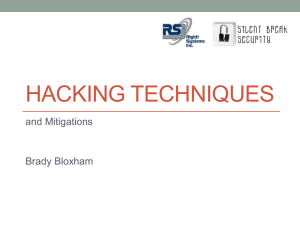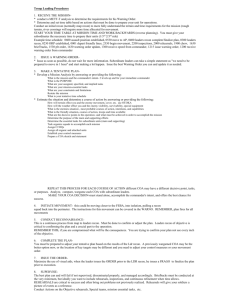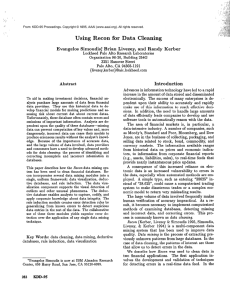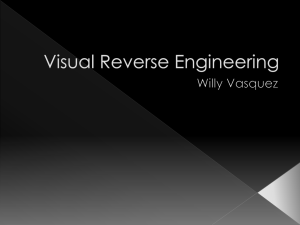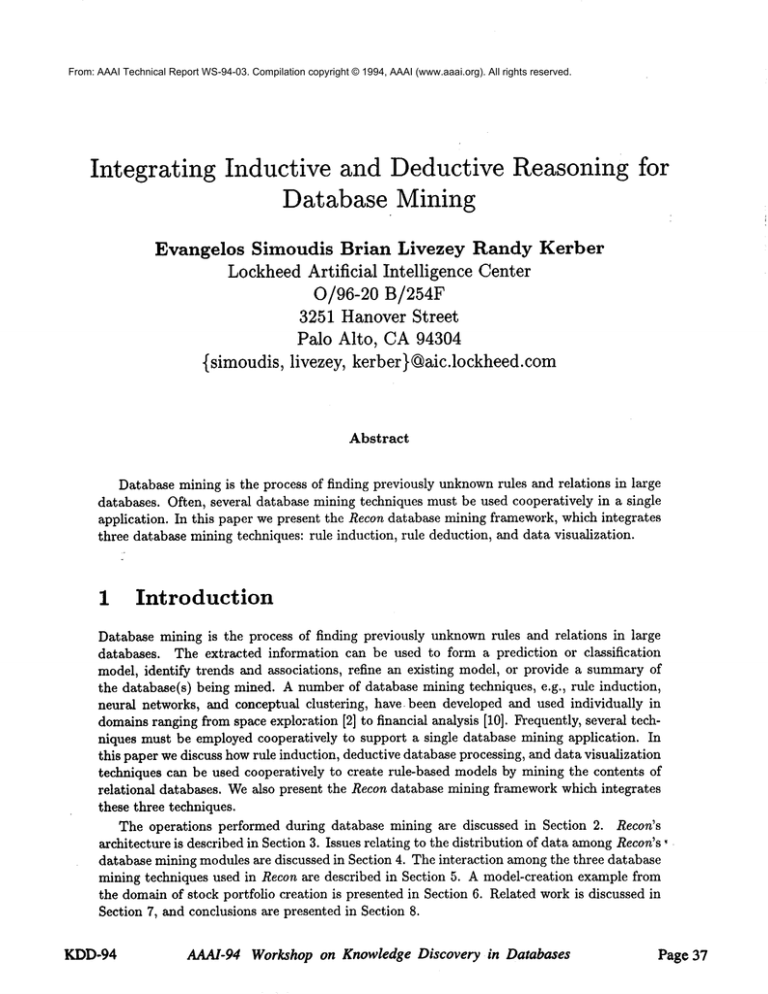
From: AAAI Technical Report WS-94-03. Compilation copyright © 1994, AAAI (www.aaai.org). All rights reserved.
Integrating Inductive and Deductive Reasoning for
Database Mining
Evangelos Simoudis Brian Livezey Randy Kerber
Lockheed Artificial Intelligence Center
0/96-20 B/254F
3251 Hanover Street
Palo Alto, CA 94304
{simoudis, livezey, kerber}@aic.lockheed.com
Abstract
Database mining is the process of finding previously unknownrules and relations in large
databases. Often, several database mining techniques must be used cooperatively in a single
application. In this paper we present the Recon database mining framework, which integrates
three database mining techniques: rule induction, rule deduction, and data visualization.
1
Introduction
Database mining is the process of finding previously unknownrules and relations in large
databases. The extracted information can be used to form a prediction or classification
model, identify trends and associations, refine an existing model, or provide a summaryof
the database(s) being mined. A number of database mining techniques, e.g., rule induction,
neural networks, and conceptual clustering, have been developed and used individually in
domainsranging from space exploration [2] to financial analysis [10]. Frequently, several techniques must be employed cooperatively to support a single database mining application. In
this paper we discuss howrule induction, deductive database processing, and data visualization
techniques can be used cooperatively to create rule-based models by mining the contents of
relational databases. Wealso present the Recon database mining framework which integrates
these three techniques.
The operations performed during database mining are discussed in Section 2. Recon’s
architecture is described in Section 3. Issues relating to the distribution of data amongRecon’s,
database mining modules are discussed in Section 4. The interaction amongthe three database
mining techniques used in Recon are described in Section 5. A model-creation example from
the domain of stock portfolio creation is presented in Section 6. Related work is discussed in
Section 7, and conclusions are presented in Section 8.
KDD-94
AAAI-94 Workshop on Knowledge Discovery
in Databases
Page 37
2
Database
Mining and Model Creation
Models created by mining a database can be statistical,
neural, or symbolic, depending on
the mining technique used. The configuration of Recon described in this paper is tailored to
produce symbolic models.
A symbolic model consists of a set of "if ... then ..." rules. The quality of each rule is
measuredby its predictive ability, its statistical validity, its generality, and its interestingness.
For example, consider the rule "if the revenues of a publicly-traded corporation are five times
its profits for three consecutive quarters, then the return on investment of its stock during the
next quarter will be greater than 20%."This rule will be classified as (1) very predictive if, for
example, it correctly predicts the return on investment for eight out of the ten stocks, (2) statistically valid, if a statistical significance test indicates that its predictiveness could not easily
have occurred by chance, (3) very general if it is very predictive during several time periods
and is relevant for a large number of stocks, and (4) very interesting if it provides a useful
insight to the analyst. The rule "the return on investment of stocks issued by pharmaceutical
companies is greater than 20%" may have been very predictive during the summer of 1992
but not at present. The rule is not very general because it only applies during a single time
period and it only characterizes stocks of pharmaceutical companies, a small percentage of the
stocks traded in the various exchanges. It may, however, be very interesting if the stocks of
pharmaceutical companies do not usually provide high returns on investment.
The mining of such rules is a process of incremental refinement performed by interweaving
three operations: (1) testing and refinement of rules hypothesized by the analyst, (2) automatic discovery of rules by the database mining system, and (3) integration of the best of the
hypothesized and discovered rules into a cohesive model.
Analysts often hypothesize value-prediction and classification rules as well as trends and
associations. For example, an investment analyst may have hypothesized the first rule above.
Since the quality of this rule is not knowna priori, the rule must be tested against historical
data. The test results allow the user to establish the rule’s quality. The testing could lead the
analyst to accept the rule and incorporate it into the model being developed, refine the rule,
or reject it altogether. In somecases, such analysis maylead the analyst to discover erroneous
data.
Analysts cannot hypothesize all the rules that might be included in a model. The data
mining system explores the contents of the database to automatically identify rules supported
by the data. For example, by exploring the target database, a rule induction component may
form a rule stating that "if a company’s earnings per share growth is greater than 50%during
six consecutive quarters, then the return on investment of its stock during the quarter following
this period will be greater than 20%." The rules resulting from automatic discovery can be
ranked according to their discriminating power. The discovered rules can also be tested on a
different database so that their predictive ability and generality can be established. Using all
of the provided information, the user selects a subset of the discovered rules, possibly edits
them, and incorporates them into the model being developed.
3
Recon’s Architecture
Recon consists of: a commandmodule, a server, one or more database mining modules, a
knowledge repository, and interfaces to relational database managementsystems. In Recon
rule validation is performed using the IDEAdeductive database processor [4]. Rule discovery is
Page 38
AAAI-94 Workshop on Knowledge Discovery
in Databases
KDD-94
Figure 1’ The architecture
of the Recon database mining framework
performed using the OTISrule induction system [5] and a data visualization system [8]. Recon’s
architecture is shownin Figure 1.
The analyst uses the commandmodule to connect to a particular database. The server interacts with the database managementsystem of the connected database by issuing Structured
Query Language (SQL) commands through the database Application Programming Interface
(API). The Recon server distributes data and knowledge among the connected database and
the database mining modules.
4
The Recon Server
Recon’s data and knowledge distribution operations are performed by the Recon server. The
server maintains the target database, allows the user to direct data from the deductive database
module to the other database mining modules, maintains the knowledge repository, and distributes stored knowledge and data to the Recon modules.
The target database is created and refined through interaction between the user and the
Recon server. In particular, after the user connects to a database, the Recon server automatKDD-94
AAAI-94 Workshop on Knowledge Discovery
in Databases
Page 39
Figure 2: Schema information
of a database with corporate
stocks
icalry extracts the database’s schema and displays it in the Query Matrix. A portion of the
extracted information from a database of corporate stocks is shownin Figure 2.
The Query Matrix presents the database’s tables (base relations) along the vertical axis
and attributes along the horizontal axis. The squares in the matrix indicate which attributes
appear in which tables. More detailed information about a particular table can be seen by
selecting a relation in the Query Matrix.
Using the base relations from the Query Matrix, the analyst can employ the deductive
database module to define new domain-specific concepts; this process is described in Section 5.2. Recon’s server automatically incorporates each concept into the target database’s
schema, displaying it in the Query Matrix, so that it can be used seamlessly with the base
relations in subsequent queries or concept definitions. These definitions can be sent to the rule
induction module to be incorporated as antecedents in the discovered rules.
Often, analysts use Recon’s database mining modules on only a subset of the database.
These subsets, called data sources, are defined by querying the target database. Data sources
are maintained by the Recon Server and can be stored explicitly by saving the results of the
query, or implicitly by saving the query itself. The Recon server can randomly sample a data
source if further reduction is necessary. In Figure 3, the user has selected the data source
called "solvent" and indicated that the data source should be loaded into the visualization
module.
Page 40
AAAI-94 Workshop on Knowledge Discovery
in Databases
KDD-94
Figure 3: Selecting a data source using the Recon server
5
Deduction,
Induction,
and Visualization
In this section we describe how Recon’s three database mining modules can be used cooperatively to create a rule-based classification model. In a typical scenario, the analyst first gets a
"feel" for the contents of the target database using the visualization module. In the process,
he may identify relations between various attributes which he proceeds to encode using the
deductive database module. The analyst invokes the rule induction module, provides it with a
sample of the target database over which to discover rules, and initiates the discovery process.
While the rule discovery operation proceeds in the background, the analyst hypothesizes and
tests other rules using the deductive database module. As part of the testing process, data
generated by the deductive database module may be sent to the visualization module for more
detailed exploration. At any point, the analyst may(1) interrupt the rule discovery operation,
(2) use the Recon server to import into the rule induction module encoded concepts, and/or
validated rules from the knowledge repository, thereby "seeding" this module’s knowledge
base, and (3) restart the induction process. The user selects a subset of the induced rules
be stored in the knowledgerepository.
5.1 Data visualization
Data visualization is particularly appropriate both for obtaining a global view for a data set
and also for noticing important phenomenathat hold for a relatively small subset of a data
set. Such phenomenaoften tend to be "drowned out" by the rest of the data when statistical
methods are used. Furthermore, the analyst does not need to know specifically the type of
phenomenahe is looking for in order to notice something interesting. In addition, whenused
on data with distributions that are not well-behaved, visualizations tend to be more effective
than manystatistical
methods, because the latter often makelimiting assumptions about the
data distributions.
The visualization process begins with the user selecting a data source from the Recon
server and importing it into the visualization module. Recon’s visualization module permits
the analyst to:
¯ Marksubsets of the data set that are of particular interest.
using a different color.
Each such subset is plotted
¯ Focus on a portion of the displayed data. For example, Figure 4 shows a simple visualization that includes two scatter plots produced by Recon’s visualization module created
KDD-94
AAAI-94 Workshop on Knowledge Discovery
in Databases
Page 41
Figure 4: Visualization of data about publicly traded companies
in order to determine the relationship between current-assets madliabilities
of solvent
companies. The top scatter plot includes the entire contents of the data source (see
Figure 3). The bottom scatter plot provides more detail of the area indicated by the
rectangle on the top scatter plot. In this case, it was selected to include companiesthat
show an almost linear relationship between current-assets and liabilities.
¯ Select a portion of the data displayed in one visualization, e.g., a two-dimensional scatter plot, and visualize the values of attributes of interest using another visualization,
e.g., a two-dimensional line plot. For example, after establishing, through the use of a
.o two-dimensional scatter plot, that there exists an almost-linear relationship between the
values of the current assets and current liabilities attributes, the analyst can select the
data points that obey this relationship and display the values of their quarterly earnings
over a period of a year using a two-dimensional line plot.
¯ Select a subset of the data to export to another Recon module for further analysis.
5.2
Deductive
database
processing
Recon’s deductive database moduleis used for formulating queries, defining concepts, or derived
relations, representing rules to be validated, and refining existing concepts and rules.
A concept is defined in terms of its name, a set of attributes, and one or more relations
amongthe attributes. An attribute mayeither belong to one of the database’s base relations,
or be part of another, previously defined, concept. The user selects the appropriate relations
and/or concepts from the Query Matrix and relates the attributes by specifying equalities and
inequalities amongthe attributes.
The new concept is incorporated into the Query Matrix
and can be used in future queries, concept definitions, and rules.
A database that contains such user-defined knowledge is called a deductive database. The
values of concepts are not stored in the database. They are computed dynamically via deductive inferences in response to a user’s query. In particular, after a query is formulated by
the user it is automatically expanded by the deductive database moduleuntil it consists solely
of base relations and computable functions. The deductive database module transforms each
Page 42
AAAI.94 Workshop on Knowledge Discovery
in Databases
KDD-94
expanded query into a set of optimized SQLexpressions. The expanded query is then posed
to the target database.
The deductive database module provides justifications for query responses. The justifications detail the exact chain of reasoning that led to the result in question. In this way, the user
can better understand the results and determine whether the definitions of particular concepts
need to be modified/refined, or whether the data in the target database is anomalous.
The analyst also uses the deductive database module to form "if... then ..." rules. The
antecedents and consequents of these rules may contain a mixture of user-defined concepts
and base relations. The deductive database module expands the included concepts, as was
described above, and automatically creates two queries which, after optimization, are posed
to the target database. The first query returns the set of records that support the rule.
The second query returns the set of records that match the rule’s left-hand side but do not
match its right-hand side. From the returned information the analyst determines the rule’s
discrimination ability, thus starting to establish the rule’s quality. The user can also obtain a
justification of whyeach answer was included in each of the two returned sets. To this end, the
deductive database moduledisplays, in the form of a proof tree, the concept-reduction process
it followed. The user can view the definition of each concept included in this justification by
selecting the desired concept in the proof tree.
5.3
Rule induction
While the deductive database module allows the analyst to express knowledge and test it
against the target database, rule induction is used to automatically explore the target database
to discover rules that characterize its contents. The data presented to the rule induction module
must belong to a small set of classes that have been predefined by the user. For example,
assume that the target database contains historical data about the quarterly performance of
stocks, including the quarterly return on investment of each stock. Further assume that the
analyst defines two classes: "high return on investment," for stocks with quarterly return on
investment greater than 20%, and "low return on investment," for the rest of the stocks. The
induced rules express generalizations over the input data that are useful for distinguishing
amongthese classes.
Recon’s rule induction module is based on the OTIS rule induction system [5]. It was
selected for inclusion into Recon over other such algorithms for three reasons. First, it is able
to produce high quality rules even when the input data is noisy and incomplete. Second, it
generates "if ... then ..." rules, the same representation used by Recon’s deductive database
module. Finally, it is able to accept knowledge defined using the deductive database module.
Such domain knowledge expedites the rule discovery task while simultaneously improving the
quality of the induced rules.
Since it is rarely possible to find a single, perfect discriminating rule that matches all
examples in one class and no examples in any other class, Recon’s rule induction module
produces a collection of rules, each of which is assigned a strength factor to indicate howwell
it predicts the target attribute. This factor is one of the measures used by the analyst to
establish each rule’s quality.
The user can establish the predictive ability and generality of the induced rules by testing
them against the contents of another data source imported from the Recon server. The user
can request an explanation of why a particular prediction was made. In response to such a
request, the rule induction module displays the subset of the rules that contributed to that
prediction. After examining each rule and the weight it provided to the prediction, the analyst
KDD-94
AAAI-94 Workshop on Knowledge Discovery
in Databases
Page 43
may decide to ignore certain attributes from the input data set or refine the definitions of
concepts using the deductive database module. After making modifications, the analyst can
re-test the rule set and store some or all of the rules in the knowledgerepository.
6
Using Recon for Stock Portfolio
Creation
Wenow provide a simple example of how an investment analyst can use Recon to create a rulebased model for selecting stocks that yield a high return on investment. Creating rule-based
stock selection models is a very appropriate domain for database mining because of the large
number of stocks from which the moneymanager can select to create a portfolio and the vast
amount of historical data about each stock. The use of database mining techniques allows the
analyst to consider many more factors and much more data, thus leading to the development
of more accurate value-prediction models.
Weassume that the investment analyst has access to a database with monthly data about a
universe of stocks. The process begins by creating the target database through Recon’s server.
Assumethat the target database contains data about 1500 stocks over a period of seven years.
The user’s goal is to create a portfolio of approximately 100 stocks.
The user sends the target database, in its entirety, to the visualization module. In order to
investigate whether there exists a relationship between the values of the "Current PE" (current
price-earnings ratio) and "Recent price" attributes, the user creates a two-dimensional scatter
plot and establishes that there exists a linear relationship between the values of these two
attributes.
Next, the analyst uses the deductive database module to interactively test his knowledge
about indicators that can discriminate stocks which have the potential of providing high return
on investment. The user hypothesizes that earnings-per-share growth and dividend growth are
good indicators. He defines the concept high-growth to characterize stocks whoseearnings-pershare-growth and dividend-growth are both greater than 50%.
The analyst uses the deductive database module to formulate rules and test them against
the target database. An example rule states that "ff a stock is high-growth at time t, then its
return on investment two quarters later will be greater than 20%." The definition of this rule
is shownin Figure 5.
Oncethe user instructs Recon to test the stated rule, the system retrieves from the database
two sets of answers: the records (stocks) that support the rule and those which refute it. After
inspecting the returned information, the user decides that he has discovered a useful indicator
for high return on investment, i.e., the high-growth concept, and a useful rule. He incorporates
both of them into the model being developed. The rule is sent to the Recon server where it is
entered into the knowledgerepository.
While the analyst interactively creates indicators and tests rules, Recon’s rule induction
module automatically discovers rules by exploring a randomly selected sample of the target
database. The analyst interrupts the rule induction process and requests the rules discovered
thus far. Before presenting them to the user, the rule induction module sorts the discovered
rules based upon their discrimination power, determined by the percentage of the instances
from each class in the target database the rule matches. Figure 6 shows a subset of the induced
rules. The columns labeled "High" and "Low" indicate what percentage of each of the two
sets the rule matched.
The user tests the discovered rules by applying them to another randomly selected data
set. For each stock in this set, the rule induction module displays its return on investment
Page 44
AAA1-94 Workshop on Knowledge Discovery
in Databases
KDD-94
Figure 5: A rule expressed using Recon’s deductive
database module
prediction, along with the confidence level associated with the prediction, as well as the stock’s
actual return on investment.
The user can select individual stocks from this list and request the rationale for the associated prediction. Of particular interest are those cases where the wrong prediction was made
with a high degree of confidence. The explanation consists of the set of rules that were used to
makethe particular prediction. For example, the explanation for the stock with ticker symbol
STL is shown in Figure 7. Associated with each rule is the weight that the rule contributed
to the prediction. The sum of the individual rule weights determines the overall confidence in
the prediction.
Byexamining the evidence for incorrect predictions, the user can identify low-quality rules.
In this case, the user decides to delete the attribute INDUSTRY
from the target database
because it was only relevant during the time period covered in the target database and is not a
generally useful indicator. The user restarts the rule induction process over the revised target
database. Finally, the user selects the desired set of discovered rules and sends them to the
Recon server where they are incorporated into the knowledge repository.
The model developed through the interweaving of these three operations: visualization,
deductive database processing, and rule induction is then applied on a universe of current
stocks. The top 100 of the stocks for which the model predicts a high return on investment
are included in the portfolio.
KDD-94
AAAI-94 Workshop on Knowledge Discovery
in Databases
Page 45
Figure 6: Rules discovered by Recon’s rule induction module
Figure 7: Evidence for the return on investment prediction for STL
Page 46
AAAI.94 Workshop on Knowledge Discovery in Databases
KDD-94
7
Related
Work
A growing number of systems that perform database mining using artificial intelligence techniques have been developed in recent years. Wecompare Recon to the ones that have been
most widely reported in literature.
The comparison is done along two dimensions; the type of
database mining operations supported by each system, and the degree of integration among
each system’s components. Wecompare Recon to four systems IMACS[1], KDW[7], INLEN [3],
and MLT [9]. A more complete list of database mining systems, along with a more elaborate
comparison methodology, are provided in [6].
Our first observation is that, with the exception of IMACS,previously reported systems
support only a subset of the three operations weidentified with database mining in Section 2. In
particular, IMACS
includes a deductive database processor to perform testing and refinement of
rules hypothesized by the analyst, and a tightly integrated visualization componentthat is used
to display the results of a query. Recon’s visualization componentis not as tightly integrated
with the other components. Data is communicated between the components through the Recon
server. Another difference between IMACS
and Recon is that the former does not interact with
existing databases; data from such databases has to be loaded into memorybefore hypotheses
can be tested. Recon interacts directly with relational database managementsystems through
SQL. IMACScan be used to express and test more complex structures than Recon. This is
because Recon is currently limited by what can be expressed in SQL.
Fromthe pattern discovery perspective, Recon is most closely related to the KDW,INLEN,
and MLT systems in three respects. First, all three systems use the same methods (inductive
learning, and visualization) to perform pattern discovery. Recon currently includes a single
rule induction system, whereas each of the other three systems includes a multitude of methods
that provide the capability for broad experimentation. Such experimentation is necessary in
research but not as much in application development. Second, all systems allow knowledge
sharing between the components they integrate. The degree of componentintegration in these
systems varies. Recon and KDWare loosely integrated systems. The components of INLEN
and MLT are more tightly integrated. Each of these two systems uses a custom-developed
knowledge representation that allows the components to share knowledge.
8
Conclusions
Wehave successfully applied Recon in: (1) financial domains to develop prediction models
from data about stocks and commodities, (2) manufacturing domains to extract information
that allowed for the correction of manufacturing process failures, and (3) demographicdata
identify potential customers in product marketing campaigns. Our work to date has allowed
us to reach the following conclusions:
1. Effective database mining is performed through the interweaving of several operations,
the primary of which are testing and refining rules proposed by the analyst, and automatically discovering rules.
2. Twoor more techniques often need to be used cooperatively to achieve the desired result.
Recon provides the analyst with techniques for all identified database mining operations.
These techniques have been integrated in a way that enables them to be used cooperatively.
KDD-94
AAAI-94 Workshop on Knowledge Discovery
in Databases
Page 47
Current work on Recon includes the improvement of the search techniques used by its
artificial intelligence modules, improvementof the server’s functionality, and the application
of the system in additional domains.
References
[1] R. Brachman,P. Selfridge, L Terveen, B. Altman, F. Halper, T. Kirk, A. Lazar, D. McGuiness, L. Resnick, and A. Borgida. Integrated support for data archaelogy. In Proceedings
1993 AAAI Workshop on Knowledge Discovery in Databases, pages 197-211. AAAI, 1993.
[2] Usama Fayyad and Padhraic Smyth. Automated analysis of a large-scale sky survey:
the skicat system. In Proceedings of the Knowledge Discovery in Databases (KDD-93)
Workshop, pages 1-13, 1993.
[3] K. Kaufman, R. Michalski, and L. Kerschberg. Mining for knowledge in databases: Goals
and general description of the INLENsystem. In Proceedings of the 1991 AAAI Workshop
on Knowledge Discovery in Databases, pages 35-51. AAAI,1991.
[4] C. Kellogg and B. Livezey. Intelligent data exploration and analysis. In Proceedings of
the Conference on Information and Knowledge Management (CIKM-9P), 1992.
[5] R. Kerber. Learning classification rules from examples. In Proceedings 1991 AAAI Workshop on Knowledge Discovery in Databases. AAAI, 1991.
[6] C. Matheus, P.K. Chan, and G. Piatetsky-Shapiro. Systems for knowledge discovery in
databases. IEEE Transactions on Knowledge and Data Engineering, 5(6), 1993.
[7] G. Piatetsky-Shapiro
and C. Matheus. Knowledge discovery workbench for exploring
business databases. Intarnational Journal of Intelligent Systems, 7, 1992.
[8I’E. Simoudis, D. Klumpar, and K. Anderson. Rapid visualization environment: Rave. In
Proceedings of the 9th GoddardConferenceon Space Applications of Artificial Intelligence,
May 1994.
[9] Marc Uszynski. Machine learning
munity, Esprit II, 1992.
toolbox. Technical report,
European Economic Com-
[10]W. Ziarko,
R. Golan, and D. Edwards. An application of datalogic/r knowledge discovery tool to identify strong predictive rules in stock market data. In Proceedings of the
Knowledge Discovery in Databases (KDD-93) Workshop, pages 89-101, 1993.
Page 48
AAAI-94 Workshop on Knowledge Discovery
in Databases
KDD-94

